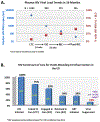The HIV Continuum of Care for Adolescents and Young Adults Attending 13 Urban US HIV Care Centers of the NICHD-ATN-CDC-HRSA SMILE Collaborative
- PMID: 32267659
- PMCID: PMC7147723
- DOI: 10.1097/QAI.0000000000002308
The HIV Continuum of Care for Adolescents and Young Adults Attending 13 Urban US HIV Care Centers of the NICHD-ATN-CDC-HRSA SMILE Collaborative
Abstract
Background: Almost one-quarter of all new HIV diagnoses in the United States occur among persons aged 13-24 years. These youths have the poorest HIV care continuum (HCC) outcomes, yet few empirical youth-specific data are available.
Methods: The Strategic Multisite Initiative for the Identification, Linkage, and Engagement in Care of HIV-infected youth (SMILE) helped HIV-infected (mostly newly diagnosed) youth, aged 12-24 years, link to youth-friendly care, and evaluated each milestone of the HCC (October 2012-September 2014). Numbers of HIV-infected youth referred, linked, engaged, and retained in care were recorded, along with sociodemographics. Viral suppression (VS) was defined as ≥1 HIV viral load (VL) below the level of detection on study. Correlates of VS were examined using Cox proportional hazards models.
Results: Among 1411 HIV-infected youth, 1053 (75%) were linked, 839 (59%) engaged, and 473 (34%) retained in care at adolescent health care sites. Antiretroviral therapy was initiated among 474 (34%), and 166 (12%) achieved VS. Predictors of VS included lower VL at baseline [aHR 1.56 (95% CI: 1.32-1.89), P < 0.0001], recent antiretroviral therapy receipt [aHR 3.10 (95% CI: 1.86-5.18), P < 0.0001], and shorter time from HIV testing until referral to linkage coordinator [aHR 2.52 (95% CI: 1.50-4.23), P = 0.0005 for 7 days to 6 weeks and aHR 2.08 (95% CI: 1.08-4.04), P = 0.0294 for 6 weeks to 3 months compared with >3 months].
Conclusions: Although this large national sample of predominately newly diagnosed youths linked to care at similar rates as adults, they achieved disproportionately lower rates of VS. Prompt referral to youth-friendly linkage services was an independent predictor of VS. Youth-focused interventions are urgently needed to improve their HCC outcomes.
Conflict of interest statement
The authors have no conflicts of interest to disclose.
Figures

References
-
- CDC. HIV Among Youth. 2016; http://www.cdc.gov/hiv/pdf/group/age/youth/cdc-hiv-youth.pdf. Accessed June 29, 2016.
-
- CDC. Estimated HIV incidence and prevalence in the United States, 2010–2016. HIV Surveillance Supplemental Report 2019;24(No. 1). 2019; https://www.cdc.gov/hiv/pdf/library/reports/surveillance/cdc-hiv-surveil.... Accessed May 1, 2019.
-
- CDC. Fact Sheet: Trends in U.S. HIV Diagnoses, 2005-2014. 2016; https://www.cdc.gov/nchhstp/newsroom/docs/factsheets/HIV-Data-Trends-Fac.... Accessed March 4, 2019.
Publication types
MeSH terms
Grants and funding
LinkOut - more resources
Full Text Sources
Medical

